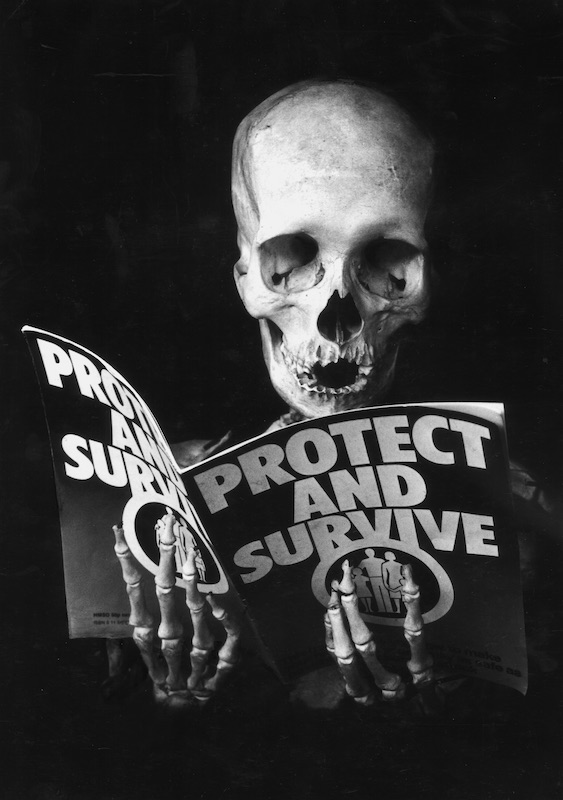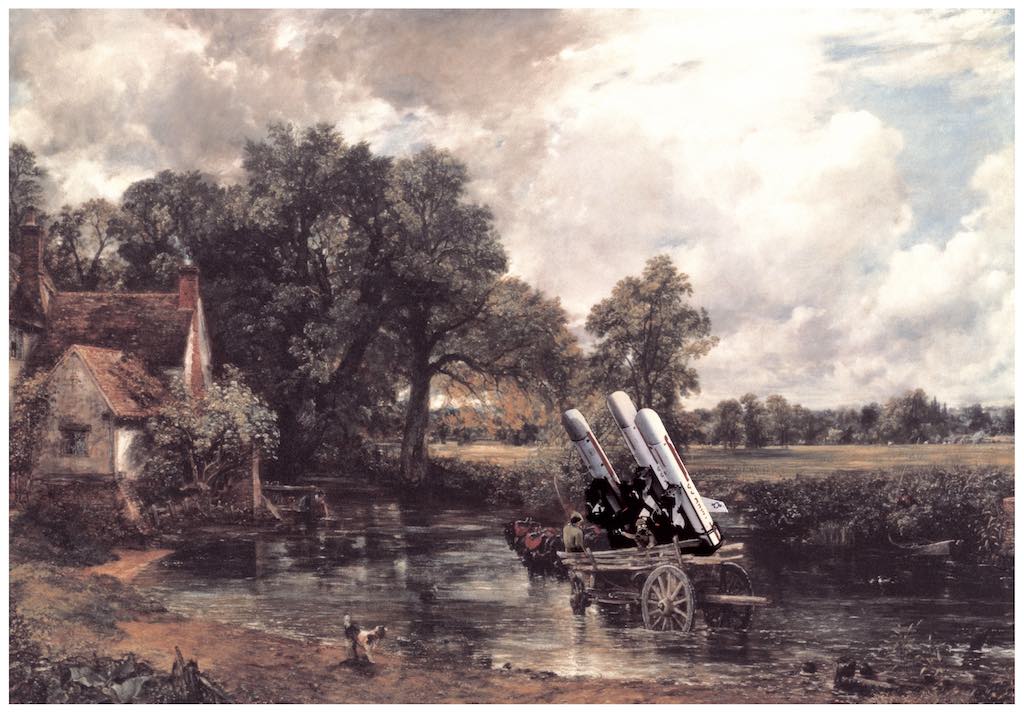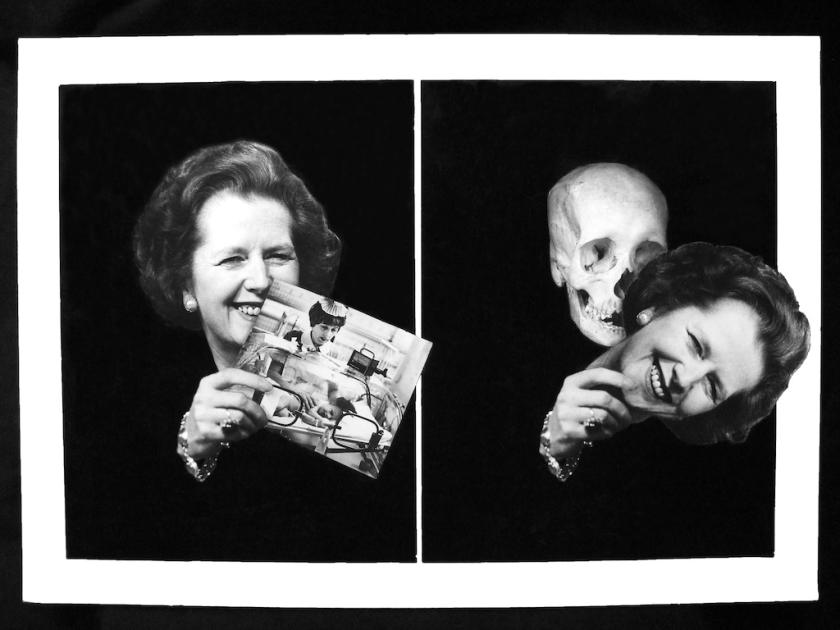Peter Kennard: Archive of Dissent at the Whitechapel Gallery includes many of the artists’s most iconic political photomontages. Beginning in the 1970s, Kennard created images that by speaking truth to power, gave protest movements like CND (Campaign for Nuclear Disarmament), the Anti-Apartheid Movement and Stop the War Coalition the visual equivalent of marching songs.
Influenced by John Heartfield who, in 1930s Germany, used his scissors to create lacerating images denouncing Nazism, Kennard has similarly gone on the attack to reveal the hypocrisy of politicians, his revulsion at war and the insanity of the arms race and, more recently, the ruthless exploitation of the planet’s resources.
“My art,” he writes, “erupts from outrage at the fact that the search for financial profit rules every nook and cranny of our society. Profit masks poverty, racism, war, climate catastrophe and on and on… By cutting, tearing, montaging and juxtaposing imagery that we are all bombarded with daily, it shows what lies behind the mask… It rails at the waste of lives caused by the trillions spent on manufacturing weapons and the vast profits made by arms companies.”
 There’s a smiling Margaret Thatcher (main picture) holding up a photo of a nurse working in intensive care. But Maggie as a caring philanthropist is juxtaposed with another picture revealing her charming smile to be a mask hiding a skull. Kennard’s Maggie is an angel of death, not a saviour of lives.
There’s a smiling Margaret Thatcher (main picture) holding up a photo of a nurse working in intensive care. But Maggie as a caring philanthropist is juxtaposed with another picture revealing her charming smile to be a mask hiding a skull. Kennard’s Maggie is an angel of death, not a saviour of lives.
In 1974 the government issued Protect and Survive, a pamphlet advising people on how to survive a nuclear attack. Anyone gullible enough to believe that their advice might save them would, inevitably, end up like Kennard’s reader – as a skeleton (pictured right).
Created in 1983 as a poster for Stop the War Coalition, Defended to Death shows our planet as a head wearing protective goggles. One eye bears the American flag, the other the Chinese Hammer and Sickle; and spewing from its mouth, like broken teeth, are dozens of rockets. Nowhere, it seems, is safe. Even the cart in Constable's famous painting of rural England, The Hay Wain (1821) has been laden with cruise missiles (pictured below) and the farm boy is wearing a gas mask.
Created in 2007 for CND, No Trident shows a missile slamming into the CND symbol of peace and breaking on impact. Coruscating images come with pithy captions. Welcome to the G8, for instance, accompanies a montage of a soldier kicking the globe about like a football.
The most powerful part of the show is a display of these posters which, throughout the 1970s and ‘80s were carried by hundreds of protestors on countless marches. Their impact comes from their simplicity; the messages are clear, concise and very dramatic. Employing black humour, irony, visual puns and double entendre, they are so succinct that words can’t do them justice.
Kennard’s recent installations are more complicated. To emphasise the relationship between power, money and the destruction of our planet, in Boardroom (2023), he projects his most potent images onto pages of the Financial Times. Rather than doubling the revelatory power of the pictures, though, it dilutes it. Instead of packing a punch, they now mumble a convoluted message. The same is true of Double Exposure (2023) in which a complex array of glass slides, lights and projected images are employed to make political points. The business card of DENYA, an Israeli construction and infrastructure company, casts a shadow over the eyes of a projected face – blinding it. Given the devastation that Israel is currently inflicting on the Palestinians and the way protesting voices are being silenced, the work should supercharge a flash of anger; but it doesn’t. Instead of aiming to deliver a clear message, the set-up focuses on the process through which the montage is produced.
The same is true of Double Exposure (2023) in which a complex array of glass slides, lights and projected images are employed to make political points. The business card of DENYA, an Israeli construction and infrastructure company, casts a shadow over the eyes of a projected face – blinding it. Given the devastation that Israel is currently inflicting on the Palestinians and the way protesting voices are being silenced, the work should supercharge a flash of anger; but it doesn’t. Instead of aiming to deliver a clear message, the set-up focuses on the process through which the montage is produced.
After 50 years of creating knock-out images, the artist clearly wants to change tack, especially as he feels that all those placards, posters and political montages achieved very little. The problems he addressed have, after all, got worse rather than better. Surely, though, this means that the skills he employed to such excoriating effect are needed more than ever. Let's hope that Peter Kennard’s exhibition will inspire another generation of protestors to take to the airwaves and the streets armed with images as powerful as his.
- Peter Kennard: Archive of Dissent at the Whitechapel Gallery until 19 January 2025
- More visual arts reviews on theartsdesk










![SEX MONEY RACE RELIGION [2016] by Gilbert and George. Installation shot of Gilbert & George 21ST CENTURY PICTURES Hayward Gallery](/sites/default/files/styles/thumbnail_125_x_125_/public/mastimages/Gilbert%20%26%20George_%2021ST%20CENTURY%20PICTURES.%20SEX%20MONEY%20RACE%20RELIGION%20%5B2016%5D.%20Photo_%20Mark%20Blower.%20Courtesy%20of%20the%20Gilbert%20%26%20George%20and%20the%20Hayward%20Gallery._0.jpg?itok=3oW-Y84i)




Add comment